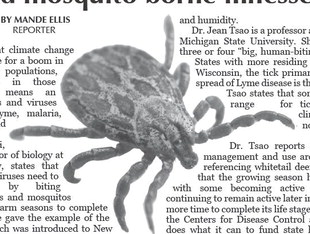Tick and mosquito borne illnesses rise as region gets warmer


Experts state that climate change could be responsible for a boom in tick and mosquito populations, and an increase in those populations also means an increase in diseases and viruses like West Nile, Lyme, malaria, dengue fever, and Powassen.
Dr. Erin Mordecai, an associate professor of biology at Stanford University, states that these diseases and viruses need to be transmitted by biting arthropods like ticks and mosquitos which depend on warm seasons to complete their life cycles. She gave the example of the West Nile virus which was introduced to New York State in 1999. Since then, the state’s warm season has increased by an additional 25 days, making the climate more suitable for arthropods that transmit West Nile.
“As it stays and gets warmer longer and faster, there are a larger number of cases in humans,” Dr. Mordecai said.
Dengue fever, which is passed through infected mosquitos and punctuated by sudden high fever, severe headache and pain behind the eyes, joint and muscle pain, nausea and vomiting, skin rash, and fatigue, is typically found in tropical regions but has recently been discovered in the United States in places like Florida, Texas, California, and Hawaii. 2024 was the worst year on record, and Dr. Mordecai states that as climates become more favorable, people should expect to see more local transmission of dengue fever.
She also explained that changes in land use may also be a contributing factor. Dr. Mordecai stated that fragmenting forests can alter what kinds of animals inhabit an area and some animals make better hosts than others, such as whitetail deer, which are a food source for both ticks and mosquitos. She reported that availability of wetlands and the movement of people can also be a source of introduction, in addition to changes in precipitation and humidity.
Dr. Jean Tsao is a professor and disease ecologist at Michigan State University. She says that there are three or four “big, human-biting” ticks in the United States with more residing on the East Coast. In Wisconsin, the tick primarily responsible for the spread of Lyme disease is the black-legged tick. Dr. Tsao states that some of the expansion in range for ticks is partly due to climate change, but partly not. Like Dr. Mordecai, Dr. Tsao reports that changes in land management and use are likely a factor, again referencing whitetail deer. She goes on to state that the growing season has expanded for ticks with some becoming active a little earlier and continuing to remain active later in the warm season with more time to complete its life stages. Dr. Tsao reports that the Centers for Disease Control and Prevention (CDC) does what it can to fund state health departments to conduct systematic surveillance of ticks, but funding is an issue. Another obstacle is the lack of collation of data from different sources.
Dr. Lyric Bartholomay, an associate professor at the UW School of Veterinary Medicine, reports that while female mosquitos need blood, adult mosquitos also need access to sugar and nectar sources as well as safe places to land. Immature mosquitos require standing water. “Record rainfall and record high temps become the perfect storm for mosquitos to lay eggs and allow their immature to grow,” Dr. Bartholomay said. “When the duration of time it takes for mosquitos to go from egg to adult is shortened, there are lots of opportunities to create lots of mosquitos.”
These experts recommend prevention as the best method to protect yourself from viruses and diseases. DEET-based repellents can be highly effective and longlasting. Dr. Tsao suggests clothing treated with insecticides or permethrin which are effective in repelling arthropods but toxic to cats and aquatic life. Lawn treatments can help, though she states that ticks don’t typically live in lawns, and homes bordering forests may not see a decline in activity even with lawn treatments. Even then, mosquitos can develop a resistance to some products.
Using larvicides in ponds or water features will discourage larvae from growing, as well as keeping gutters clean. Reducing the standing water on your property can significantly decrease the opportunity for immature mosquitos to grow, and encouraging predators like birds, bats, dragonflies and tadpoles to frequent your area is beneficial. Some plants will repel mosquitos, such as citronella, lavender, marigolds, and catnip. While encouraging predators and planting natural repellents is helpful, neither is enough on its own.
“A lot of people just don’t know that mosquitos aren’t just a nuisance,” said Dr. Mordecai. “They can actually transmit disease to you.”


